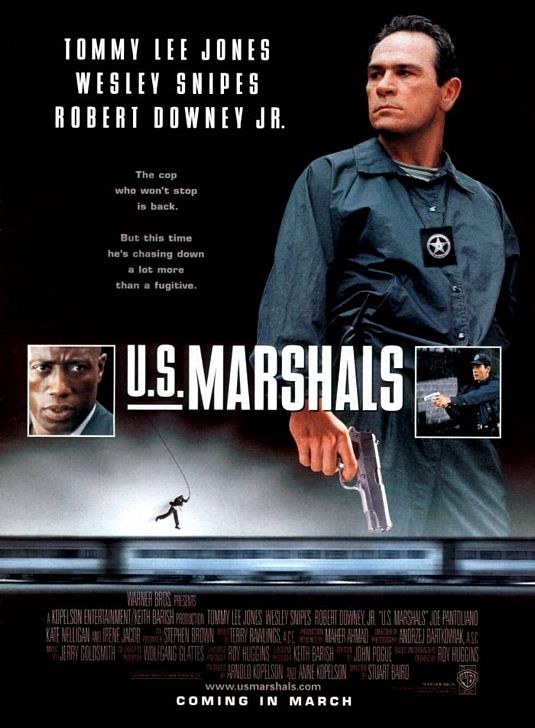"Cut to the Chase"

| None | Light | Moderate | Heavy | |
|---|---|---|---|---|
| Language | ||||
| Violence | ||||
| Sex | ||||
| Nudity |
What You Need To Know:
In U.S. MARSHALS, Wesley Snipes plays an ex-covert CIA operative who has to kill two foreign agents in self-defense in a UN parking garage. He is arrested but escapes from a fiery plane crash as Tommy Lee Jones heads up the United States Marshals’ search and apprehension team. Rife with foul language and extreme action violence, U.S. MARSHALS is a contemporary western that presents clever variations on the 1990s formula chase movie, but is less engrossing than its predecessor, THE FUGITIVE, although it has enough mayhem to morally desensitize audiences all over America and the world.
What distinguishes U.S. MARSHALS from other big-budget movies is the relentless violence and gunplay in nearly every scene. Although the story takes viewers on an interesting intellectual ride, the overall emotional impact is deadening. With killing after killing, viewers are treated to an extravagant gore-fest. With more than a dozen killings and 46 obscenities in this movie, it is, in fact, incomprehensible how the movie could have received a PG-13 rating from the MPAA. U.S. MARSHALS is surely one of the most flagrant examples of movie ratings creep in recent years. What kind of parents would knowingly let their 14-year-old view a dozen graphic killings in the course of a two-hour movie
Content:
(Pa, I, P, LLL, VVV, M) Pagan worldview with internationalist, patriotic & heroic elements; 46 obscenities & 5 profanities; extreme violence with more than a dozen graphic shootings, stabbings & killings, including man shoots man, man stabs man, men shoot men, & man wrestles man; alcohol; anti-smoking attitudes; and, betrayal.
More Detail:
U.S. MARSHALS is no FUGITIVE. Despite its hit movie pedigree, including the 1963-1967 ABC-TV series, starring David Janssen, and the 1993 hit movie THE FUGITIVE, U.S. MARSHALS does not excite viewers as did the Harrison Ford-Tommy Lee Jones interaction in the 1993 Warner Bros. movie. Although well directed and boasting the same high-profile cast as did THE FUGITIVE minus Harrison Ford, U.S. MARSHALS is a more bland, but foul-language-laden sequel to THE FUGITIVE, rife with extreme action violence.
In U.S. MARSHALS, Tommy Lee Jones reprises his trademark of relentlessly serious facial expressions which have won him admirers all over the world. Although it presents clever situational variations on the 1990s formula chase movie, U.S. MARSHALS is less engrossing than its predecessor, THE FUGITIVE. It still contains enough gross mayhem and indiscriminate killings to morally desensitize audiences all over America and the world.
U.S. MARSHALS begins as Chicago police arrest a man named Roberts (Wesley Snipes) when a routine fingerprint investigation after a catastrophic traffic accident investigation reveals he is wanted for two murders. Chief Deputy U.S. Marshal Sam Gerard (Tommy Lee Jones) and other officers escort Roberts and more than a dozen other hardened convicts on a prisoner transport jet from Chicago to New York.
At this point, the movie resembles Disney’s 1997 movie CONAIR. As in CONAIR, something goes wrong on the plane. Another felon tries to kill Roberts, misses and blows out the side of the plane, causing it to crash-land on a deserted Kentucky roadway and then plunge spectacularly into the Ohio River. Of course, Roberts escapes, and the chase ensues.
As relentlessly obsessed with capturing his fugitive as he was in 1993’s THE FUGITIVE, Sam Gerard and his team pursues Roberts into a swamp, cross country and back to New York, where Sam discovers that Roberts is actually an ex-Marine Special Forces, ex-CIA operative named Sheridan. Sheridan is wanted for the homicides of two US Secret Service attaches who were tracking a Chinese spy ring in the US State Department. Sheridan wants to vindicate himself, to regain the reputation he once held for being “righteous.” So he goes back to his reluctant special electronic supplier to obtain high-tech surveillance equipment with which he can monitor the UN Chinese consul’s office. He then crashes a funeral, which Marshal Sam Gerard coincidentally is also attending and confronts the US State Department traitor as he picks up a satchel of cash in an anonymous mortuary drawer. Regrettably, the Chinese spy kills the traitor as Sheridan takes him at gun point away from the drop zone, and Gerard must continue to pursue his elusive quarry, who surprisingly goes out of his way to prevent people from being shot.
A contemporary western, U.S. MARSHALS takes the 1990s chase movie formula popularized by THE FUGITIVE, tweaks the storyline with some clever plot twists and presents a passably entertaining shoot-em-up movie. Instead of a spectacular train crash, there is a spectacular plane crash, with great damage and wreckage. Instead of the mysterious antagonist being a one-handed maniacal rapist-murderer, the antagonist turns out to be a much more ordinary figure. Instead of the unjustly-accused fugitive being a doctor, as was Harrison Ford in 1993’s version, Wesley Snipes is an ex-CIA operative. Instead of the G-men breaking up a medical convention, they break up a Chinese spy ring. Instead of the final scene taking place in a swanky hotel, it takes place in the hold of a giant ocean liner’s grain bin.
Otherwise, U.S. MARSHALS’ major story points remain almost identical to those of THE FUGITIVE, with chase scenes across swamps, bayous and interstates, intercutting between harrowing scenes of urban guerrilla warfare, with short interludes of backwoods police work. As in THE FUGITIVE, the discovery of the real culprit comes as a by-product of capturing the alleged perpetrator, who is exonerated at movie’s end.
What distinguishes U.S. MARSHALS from other big-budget movies is the relentless violence and gunplay in nearly every scene. Although the story takes viewers on an interesting intellectual ride, the overall emotional and spiritual impact is deadening. With killing after killing, viewers are treated to an extravagant gore-fest that rivals anything Hollywood has produced in the past ten years, and especially during the past ten years of escalating violence in PG-13 movies. With more than a dozen killings and 46 obscenities in this movie, it is, in fact, incomprehensible how it could have received a PG-13 rating from the MPAA. U.S. MARSHALS is surely one of the most flagrant examples of movie ratings creep in recent years. What kind of parents would knowingly let their 14-year-old view a dozen graphic killings in the course of a two-hour movie? With due respect to Warner Bros.’s marketing criteria for formula movie winners, they should have cut the foul language and trimmed the bullets-hitting-body scenes to have qualified U.S. MARSHALS for a PG-13 rating.



 - Content:
- Content: 


